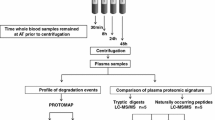Abstract
Objective
The aim of the study was to determine the extent to which plasma matrix types, diurnal rhythm and sample collection and processing procedures contribute to overall variability of measurements with the INNO-BIA plasma Aβ forms assay.
Methods
Plasma samples from healthy volunteers were collected at BARC-CRI. Analyte concentrations from various plasma matrix types (EDTA, heparin, fluoride) were compared to serum after collection of blood in commercial plastic and glass tubes. Sample processing variables including time and temperature before and after centrifugation, centrifugal force and plasma dilution factor were also investigated. Diurnal variability in plasma Aβ isoforms was determined in 29 healthy volunteers by analysis of EDTA plasma specimens serially collected over 24 hours and stored frozen following oral administration of a placebo treatment. All plasma samples from a given individual and experiment were analyzed in a single analytical run.
Results
Highest Aβ levels were obtained using EDTA-plasma samples (in contrast to serum, heparin, citrate, or fluoride). Addition of aprotinin to EDTA plasma had no effect on Aβ peptide recovery. The elapsed time and temperature exposure, before and after sample processing affects the recovery of Aβ isoforms. Analyte recovery was not significantly affected by the presence of platelets in plasma samples. At the subject level, analysis of serially collected EDTA plasma specimens from healthy volunteers revealed no evidence of diurnal variation in any of the Aβ isoforms investigated and results from samples collected on a monthly basis showed only very limited intra-individual variation.
Conclusions
Optimal recovery of Aβ peptides was obtained from blood drawn into EDTA tubes and processed within 4 h. Plasma that was refrigerated after separation and analysed within 4 h gave comparable results to samples immediately processed and frozen at −70 °C.
Similar content being viewed by others
References
Khachaturian ZS, Khachaturian AS. Public health premise for national research priorities: mortality versus disability. Alzheimer’s & Dementia 2005; 1: 2–4.
Brookmeyer R, Johnson E, Ziegler-Graham K, Arrighi HM. Forecasting the global burden of Alzheimer’s disease. Alzheimer’s & Dementia 2007; 3(3): 186–191.
Graff-Radford NR, Crook JE, Lucas J, Boeve BF, Knopman DS, Ivnik RJ, Smith GE, Younkin LH, Petersen RC, Younkin SG.Association of low plasma Abeta42/Abeta40 ratios with increased imminent risk for mild cognitive impairment and Alzheimer disease. Arch Neurol. 2007; 64: 354–362.
Schupf N, Tang MX, Fukuyama H, Manly J, Andrews H, Mehta P, Ravetch J, Mayeux R. Peripheral Aβ subspecies as risk biomarkers of Alzheimer’s disease. Proc Natl Acad Sci. 2008; 16;105:14052–14057
Andreasen N, Hesse C, Davidson P, Minthon L, Wallin A, Winblad B, Vanderstichele H, Vanmechelen E, Blennow K. Cerebrospinal fluid β-amyloid(1–42) in Alzheimer’s disease. Archives of Neurology 1999; 56: 673–680.
Olsson A, Vanmechelen E, Vanderstichele H, Davidsson P, Blennow, K. Unaltered plasma levels of β-Amyloid(1–40) and β-Amyloid(1–42) upon Stimulation of human platelets. Dementia and Geriatric Cognitive Disorders 2003;16:93–97.
Author information
Authors and Affiliations
Rights and permissions
About this article
Cite this article
Lachno, D.R., Vanderstichele, H., De Groote, G. et al. The influence of matrix type, diurnal rhythm and sample collection and processing on the measurement of plasma β-amyloid isoforms using the INNO-BIA plasma Aβ forms multiplex assay. J Nutr Health Aging 13, 220–225 (2009). https://doi.org/10.1007/s12603-009-0062-5
Received:
Accepted:
Published:
Issue Date:
DOI: https://doi.org/10.1007/s12603-009-0062-5




